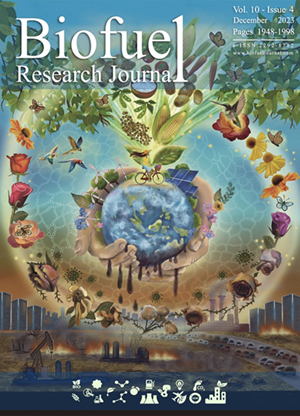橄榄厂废水的开发替代品:生产对工业和农业有用的增值化合物
IF 14.4
Q1 ENERGY & FUELS
引用次数: 25
摘要
生产橄榄油的国家产生相当数量的橄榄油厂废水,这是最有害的农业工业废水之一,具有强大的污染能力。事实上,由于其高污染负荷,这种流出物对整个土壤-空气-水生态系统以及生活在其中的生物(即植物、动物、水生生物、微生物等)都具有极大的毒性。目前,OMWW被丢弃,但由于它含有碳水化合物,有机酸和矿物质营养素,以及酚类和其他天然抗氧化剂化合物的含量升高,它可以被认为是高附加值天然产品的潜在来源。因此,橄榄油行业面临的主要挑战可能是将不同的废物流(包括OMWW)转化为精细的生化物质,并通过生物技术过程回收有价值的代谢物。鉴于此,本文的目的是总结与OMWW的开发可能性和使用有关的最新技术,以产生对生物燃料,制药,化妆品,化学,食品和农业工业具有重要意义的增值化合物。特别是通过生物炼制平台对这一重要的废蒸汽进行估值,可以大大提高整个工业的环境可持续性,同时有助于提高其经济可行性。本文章由计算机程序翻译,如有差异,请以英文原文为准。
Exploitation alternatives of olive mill wastewater: production of value-added compounds useful for industry and agriculture
Countries producing olive oil generate a considerable amount of olive mill wastewater (OMWW), one of the most harmful agro-industrial effluents with a powerful polluting capacity. In fact, owing to its high pollution load, this effluent is extremely toxic to the whole soil-air-water ecosystem as well as to the living organisms inhabiting it (i.e., plants, animals, aquatic organisms, microorganisms, etc.). Currently, OMWW is discarded but since it includes carbohydrates, organic acids and mineral nutrients, as well as elevated contents of phenolics and other natural antioxidants compounds, it could be considered as a potential source of high value-added natural products. Therefore, the valorization of different waste streams including OMWW into fine biochemicals and the recovery of valuable metabolites via biotechnological processes is probably the main challenge faced by the olive oil industry. In light of that, the aim of the present review article is to summarize the state-of-the-art in relation to the exploitation possibilities and the use of OMWW to generate added-value compounds of great significance for the biofuel, pharmaceutical, cosmetic, chemical, food, and agriculture industries. Valorization of this significant waste steam in particular through a biorefinery platform could substantially enhance the environmental sustainability aspects of the whole industry while simultaneously contributing to the improvement of its economic viability.
求助全文
通过发布文献求助,成功后即可免费获取论文全文。
去求助
来源期刊

Biofuel Research Journal-BRJ
ENERGY & FUELS-
CiteScore
22.10
自引率
1.50%
发文量
15
审稿时长
8 weeks
期刊介绍:
Biofuel Research Journal (BRJ) is a leading, peer-reviewed academic journal that focuses on high-quality research in the field of biofuels, bioproducts, and biomass-derived materials and technologies. The journal's primary goal is to contribute to the advancement of knowledge and understanding in the areas of sustainable energy solutions, environmental protection, and the circular economy. BRJ accepts various types of articles, including original research papers, review papers, case studies, short communications, and hypotheses. The specific areas covered by the journal include Biofuels and Bioproducts, Biomass Valorization, Biomass-Derived Materials for Energy and Storage Systems, Techno-Economic and Environmental Assessments, Climate Change and Sustainability, and Biofuels and Bioproducts in Circular Economy, among others. BRJ actively encourages interdisciplinary collaborations among researchers, engineers, scientists, policymakers, and industry experts to facilitate the adoption of sustainable energy solutions and promote a greener future. The journal maintains rigorous standards of peer review and editorial integrity to ensure that only impactful and high-quality research is published. Currently, BRJ is indexed by several prominent databases such as Web of Science, CAS Databases, Directory of Open Access Journals, Scimago Journal Rank, Scopus, Google Scholar, Elektronische Zeitschriftenbibliothek EZB, et al.
 求助内容:
求助内容: 应助结果提醒方式:
应助结果提醒方式:


